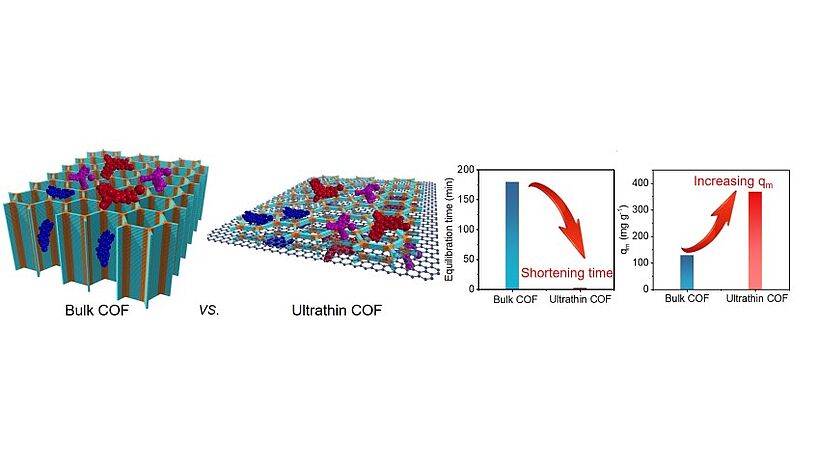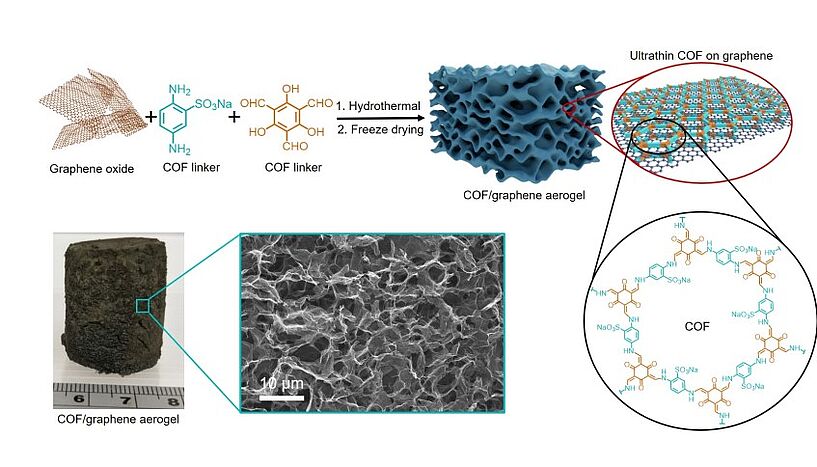Nano-sponges with potential for rapid wastewater treatment
01. August 2022Composite material of COF and graphene shows high and rapid adsorption capacity for organic pollutants
Efficient adsorbents for industrial wastewater treatment are important to minimize potential environmental damage. In particular, organic dyes, as a significant group of industrial pollutants, are usually highly water soluble, non-degradable and many are toxic to carcinogenic. Changxia Li and Freddy Kleitz from the Faculty of Chemistry of the University of Vienna together with colleagues now presented a new approach to design an innovative composite material, consisting of a nanoporous, ultrathin covalent organic framework (COF) anchored on graphene, that is highly efficient at filtering organic pollutants from water. The study was published in "Angewandte Chemie".
"There are several ways, including activated carbon filters, to purify water today, but there is still room for improvement in the efficiency or adsorption capacity of the applications," says first author and postdoctoral researcher Changxia Li.
Freddy Kleitz's group at the Institute of Inorganic Chemistry - Functional Materials is developing novel nanoporous materials. Porous materials have a much larger total surface area than a non-porous material for the same volume and can thus accumulate a particularly large number of molecules on the surfaces in the course of adsorption.
Highly porous COF as a new class of materials
Covalent organic frameworks (COFs) are a relatively novel class of materials. They are particularly porous, while at the same time being low-density and lightweight. Covalent means that their chemical bonds are formed via electron pairs between atoms.
The dyes the researchers studied in their aqueous model solution were about 0.8 to 1.6 nanometer in size. "We developed a novel method to form COF in a comparatively environmentally friendly way, using water. As such, we were able to develop small ‘sponges’, with designed pore sizes and pore shapes in the nanometer range, as well as a tuned negative surface charge, that was very selective in pulling the positively charged target molecules, i.e., our dyes, out of the water," the researchers said, "Just like the sponge soaks up the water, only in our case it's the pollutants."
A backbone made out of graphene
When using bulk COF powder, the inner pores of the material are often no longer accessible to pollutants due to pore blockage at the outer edge, especially for large pollutant molecules. The novel composite material developed by the researchers offers a thoroughly permeable structure: For this purpose, the researchers grew COF on thin-layered graphene nanosheets. The combination of graphene - in itself already a 2D layer of carbon atoms - and the layer of COF, which is up to two nanometers thick, resulted in a compact, open 3D structure. The ultrathin COF layer could expose more adsorption sites than the bulk COF powder.
On the other hand, the larger, honeycomb-like pores of the graphene network support the transport of water through the filter material. "The large pores of the graphene network in combination with the ultrathin COF layer with large amount of adsorption sites therefore enable particularly fast as well as efficient wastewater treatment," the researchers said. Due to the comparatively low material input of graphene as well as the possibility to reuse the composite material - after the pollutants have been washed out - as a filter, the development is also relatively cost-efficient, they said.
Original publication:
Ultrathin Covalent Organic Framework Anchored on Graphene For Enhanced Organic Pollutant Removal,
DOI: https://onlinelibrary.wiley.com/doi/10.1002/anie.202206564
Pictures:
Abb. 1: (a) Illustration of the dye adsorption mechanism on bulk COF and ultrathin COF. Bulk COF only allows dyes with a molecular size much smaller than the pore size to enter the COF channels, while ultrathin COF provides maximum adsorption site exposure, resulting in high uptake for various dyes. (b) Comparison of equilibrium times and maximum adsorption capacities (qm) of bulk COF and ultrathin COF for Rhodamine B. (© Changxia Li, Freddy Kleitz et al.)
Abb. 2: (a) The synthesis procedure for ultrathin COF/graphene aerogel. An ultrathin COF containing sulfonate ions with a thickness of 2 nm anchored on graphene. (b) Photograph and SEM image of ultrathin COF/graphene aerogel. The aerogel with an ultralow density of 7.1 mg cm-3 showing macroporous channels. (© Changxia Li, Freddy Kleitz et al.)
Wissenschaftlicher Kontakt
Univ.-Prof. Dr. Freddy Kleitz
Institut für Anorganische Chemie – Funktionelle MaterialienUniversität Wien
1090 - Wien, Währinger Straße 42
+43-1-4277-52902
freddy.kleitz@univie.ac.at
Rückfragehinweis
Theresa Bittermann
Media Relations, Universität Wien1010 - Wien, Universitätsring 1
+43-1-4277-17541
theresa.bittermann@univie.ac.at
Downloads:
202207_Kleitz_Ab1_01.jpg
Dateigröße: 68,14 KB
202207_Kleitz_Ab2_01.jpg
Dateigröße: 127,11 KB


